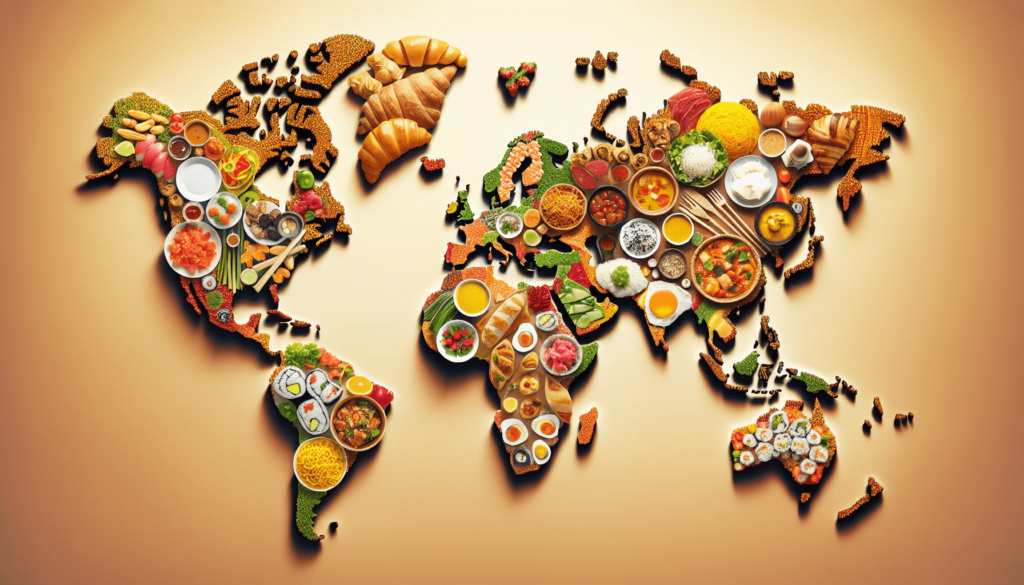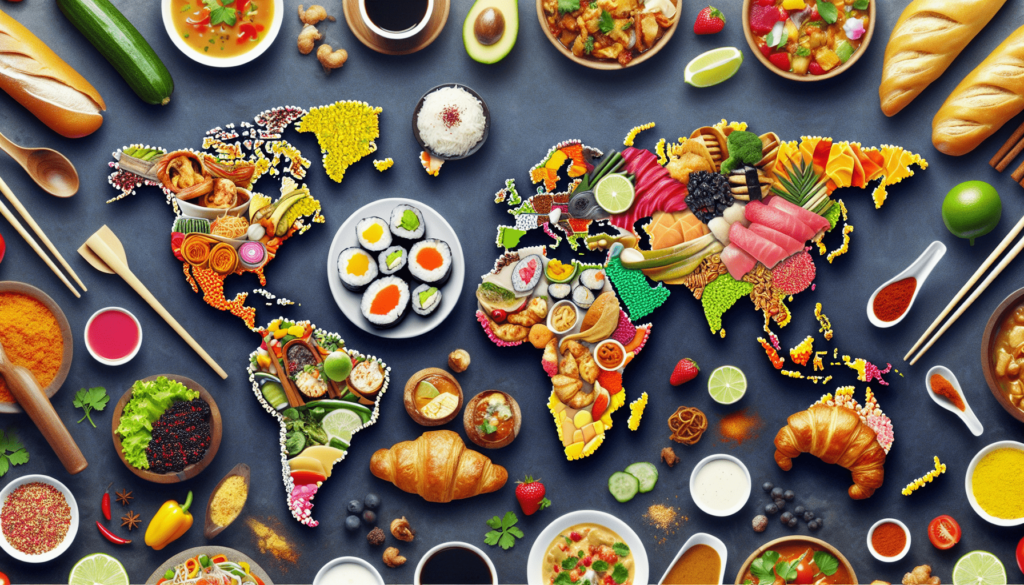Have you ever wondered what it would be like to embark on a culinary journey around the world from the comfort of your kitchen? With so many diverse cuisines and flavors to discover, the idea of tasting your way across different cultures might sound both exciting and overwhelming. Let’s take a delightful trip through various culinary landscapes, exploring the key components, unique recipes, and fascinating histories that define them.

Table of Contents
Historical Context of World Cuisines
Every culture has a rich history that significantly influences its cuisine. Take, for example, the Silk Road, which wasn’t just a network of trade routes but also a conduit for the exchange of spices and flavorings. The spread of ingredients like saffron, nutmeg, and pepper enriched many regional cuisines, creating the diverse culinary tapestry we enjoy today.
The Influence of Trade
Trade routes have always played a monumental role in shaping world cuisines. Centuries ago, explorers and merchants traveled across continents, carrying with them exotic spices and ingredients. Imagine the first time cinnamon reached Europe from Ceylon or the day chocolate from the Americas delighted European palates. These exchanges not only introduced new flavors but also revolutionized cooking methods and food preservation techniques.
Colonization and Its Culinary Impact
Colonization further expanded this culinary exchange. The Portuguese brought chilies from the Americas to India, revolutionizing Indian cuisine. Likewise, the British introduced tea to their colonies, making it an integral part of daily life in countries like India and Kenya. These historical interactions fostered a culinary diversity that’s profoundly evident today.
Current Trends in Global Cuisine
In today’s culinary world, there’s an increasing fascination with authenticity and fusion. People are not just looking for recipes; they want to understand the stories behind them. Michelin-starred restaurants serving traditional dishes are gaining prominence, while food trucks offering fusion cuisine attract long lines.
The Farm-to-Table Movement
One of the most significant trends is the farm-to-table movement. This focuses on sourcing ingredients locally to ensure freshness and sustainability. It’s about knowing where your food comes from and how it’s grown. This trend emphasizes not just the flavor but also the ethical aspects of eating.
Fusion Cuisine
Fusion cuisine combines elements from different culinary traditions to create innovative dishes. Think sushi burritos or Korean tacos. These creations not only pique curiosity but also serve as a testament to the evolving nature of the culinary landscape. The beauty of fusion cuisine lies in its ability to merge flavors in unexpected yet harmonious ways.
Exploring Regional Cuisines
To appreciate the enormity of global cuisine, let’s delve into specific regions and their iconic dishes. Each section provides a basic understanding, essential ingredients, and a signature recipe you can try at home.
Asian Cuisine
Asia offers a vast array of flavors, with each country contributing its unique twist.
Japanese Sushi
When you think of Japanese cuisine, sushi comes to mind. It’s more than just raw fish on rice; it’s an art form. The rice needs to be perfectly seasoned, and the fish needs to be the highest quality available.
Recipe: Basic Sushi Rolls
- Ingredients: Sushi rice, Nori (seaweed sheets), fresh fish (salmon, tuna), avocado, cucumber, soy sauce, wasabi.
- Instructions: Cook the sushi rice according to package instructions. Spread a thin layer on a sheet of nori, add strips of fish, avocado, and cucumber, then roll tightly. Slice and serve with soy sauce and wasabi.
Indian Curry
Indian cuisine boasts a rich history, with numerous regional variations. Curries are a cornerstone, rich in spices and herbs.
Recipe: Chicken Tikka Masala
- Ingredients: Chicken, yogurt, garlic, ginger, garam masala, coriander, cumin, tomato puree, cream.
- Instructions: Marinate the chicken in yogurt and spices, then grill. Simmer in a sauce made from tomato puree, cream, and a mix of spices until fully cooked.
European Cuisine
Europe offers a rich tapestry of culinary traditions, from hearty stews to delicate pastries.
Italian Pasta
Italian cuisine is synonymous with pasta. Its simplicity yet richness makes it a staple across the globe.
Recipe: Spaghetti Carbonara
- Ingredients: Spaghetti, pancetta, eggs, Parmesan cheese, black pepper.
- Instructions: Cook spaghetti until al dente. In a bowl, whisk together eggs and Parmesan. Fry pancetta until crispy. Combine spaghetti with pancetta, then quickly mix in the egg mixture. Serve immediately.
French Pastry
French cuisine is celebrated for its pastries, epitomized by the croissant.
Recipe: Classic Croissant
- Ingredients: Flour, butter, sugar, salt, milk, yeast.
- Instructions: Prepare dough and laminate with butter through several folds. Shape into croissants and let rise. Bake until golden brown.
Comparing Different Points of View
When discussing global cuisine, it’s interesting to compare the philosophies behind different culinary traditions.
Traditional vs. Modern Techniques
Traditional techniques like slow cooking, fermentation, and smoking have been used for centuries to enhance flavors and preserve food.
Comparison Table: Traditional vs. Modern Cooking Techniques
| Aspect | Traditional Techniques | Modern Techniques |
|---|---|---|
| Time | Often time-consuming (slow-cooked stews) | Quick, efficient (sous-vide, air frying) |
| Equipment | Minimal, basic (pots, open fire) | Advanced, specialized (vacuum sealers) |
| Flavor Profiles | Deep, developed flavors | Fresh, vibrant flavors |
Regional Variations
Take a dish like curry, for example. While Indian curry is rich and uses a variety of ground spices, Thai curry tends to be lighter and incorporates coconut milk and fresh herbs like lemongrass and basil.
Comparison Table: Indian Curry vs. Thai Curry
| Aspect | Indian Curry | Thai Curry |
|---|---|---|
| Spices | Ground spices (cumin, coriander, turmeric) | Fresh herbs (lemongrass, basil) |
| Dairy | Often includes yogurt or cream | Uses coconut milk |
| Heat | Can be very spicy | Balanced with sweetness and acidity |

The Impact of Culinary Exploration
Understanding the impact and evolution of global cuisine helps us appreciate the role food plays in cultural identity and societal development.
Cultural Impact
Food is a vital part of cultural identity. It brings people together and forms the basis for rituals and celebrations. Think of Thanksgiving in the United States or the Lunar New Year in China. These events are centered around food, underscoring its importance in social cohesion.
Economic Implications
Exploring global cuisines also has economic implications. The demand for diverse ingredients boosts local economies and supports small-scale farmers. Additionally, culinary tourism—traveling to experience another culture’s food—has become a significant industry, contributing to global economies.
Predictions and Future Directions
What does the future hold for global cuisine? Based on current trends, several predictions stand out.
Sustainability and Ethical Eating
As awareness grows, so does the emphasis on sustainable and ethical eating. In the future, expect more restaurants and home kitchens to focus on reducing food waste, using locally sourced ingredients, and adhering to fair-trade practices.
Tech in the Kitchen
Technological advancements will continue to revolutionize how we cook and experience food. From smart appliances to apps that suggest recipes based on what’s in your fridge, technology will make home cooking more accessible and tailored to individual preferences.
Global Fusion and Authenticity
The trend of global fusion will likely continue, but with a twist. Chefs and home cooks will strive to honor the authenticity of traditional dishes while incorporating elements from other cuisines in respectful and innovative ways.
Implications for Society
Understanding and appreciating global cuisines go beyond just eating good food. It fosters a greater understanding and respect for different cultures, promoting inclusivity and global unity. It also prepares us to navigate an increasingly interconnected world where culinary skills and food knowledge are highly valued.
Final Thoughts
To summarize this culinary journey, we’ve explored the rich histories, current trends, and future directions of global cuisines. Each region offers unique flavors and traditions, creating a diverse culinary landscape that enriches our lives. Whether you’re recreating a classic French croissant or experimenting with a fusion dish, understanding the story behind each recipe adds a layer of appreciation and respect.
What’s your favorite global dish, and how has it enhanced your understanding of the culture it originates from? Consider diving deeper into the culinary traditions of that region. You might find that every dish has a fascinating story waiting to be discovered.
Keep exploring, keep tasting, and remember—the world is an abundant table just waiting for you to take a seat. For more insights and recipes, don’t hesitate to explore further resources and enrich your culinary knowledge. Happy cooking!
